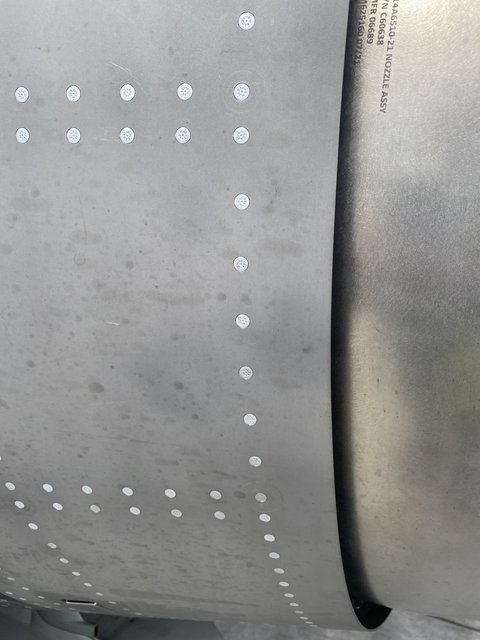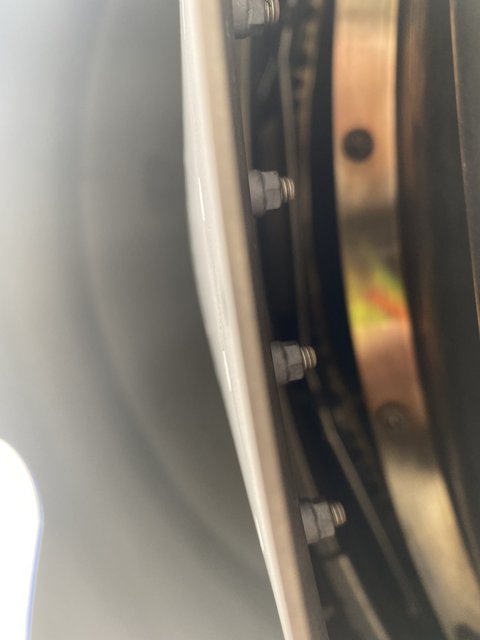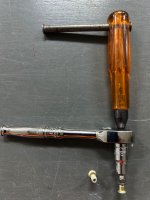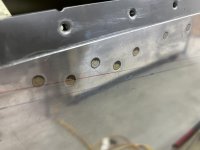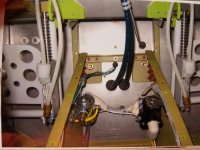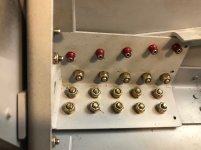Van's Air Force
You are using an out of date browser. It may not display this or other websites correctly.
You should upgrade or use an alternative browser.
You should upgrade or use an alternative browser.
Can anyone identify these aerospace fasteners?
- Thread starter Tandem46
- Start date
Looks like a self-cinching type of stud. One popular brand I use at work is PEM, so if you Google "PEM self cinching fasteners" you can learn all about them. Although the ones in that picture are probably an aerospace brand at 10x the cost.
Edit: I was wrong, and I learned about Hi-Lok pins today.
Edit: I was wrong, and I learned about Hi-Lok pins today.
Last edited:
HFS
Well Known Member
More Hi-Lok Info -
A little insight on how Hi-Lok's work -
On the Flat Head option - the included angle is 100*, just like rivets or AN/MS screws. Also, depending on the direction of the load, there are two head sizes - one for shear & one for tension.
There is an Allen hex cut into the butt of the pin to allow tightening up of the "nut".
The standard "nut" is called a "collar" and has a frangible stem, with a hex head, that breaks off at the appropriate torque setting for the pin size. When the hex head breaks off, it leaves a conical shaped collar, that is intended to be a one time installation.
In the pic shown in the original post - that part of the engine may, at some time in its operating life, need to be disassembled - hence the NAS nut allowing same.
The speciality tooling used to install Hi-Loks consists of a 1/4" drive ratchet with a hole through the head - for Allen wrench clearance, sockets that are retained with a setscrew onto the 1/4 square shaft, and a "handled" Allen wrench of the appropriate size.
FWIW: -5's make a great substitute for -4 rivets or #8 screws, where you don't want the "slots" to show, as noted in the second pic.
You can read all about them in the Genuine Aircraft Hardware Catalog - Pgs. 168-170. Good Reading.
HFS
A little insight on how Hi-Lok's work -
On the Flat Head option - the included angle is 100*, just like rivets or AN/MS screws. Also, depending on the direction of the load, there are two head sizes - one for shear & one for tension.
There is an Allen hex cut into the butt of the pin to allow tightening up of the "nut".
The standard "nut" is called a "collar" and has a frangible stem, with a hex head, that breaks off at the appropriate torque setting for the pin size. When the hex head breaks off, it leaves a conical shaped collar, that is intended to be a one time installation.
In the pic shown in the original post - that part of the engine may, at some time in its operating life, need to be disassembled - hence the NAS nut allowing same.
The speciality tooling used to install Hi-Loks consists of a 1/4" drive ratchet with a hole through the head - for Allen wrench clearance, sockets that are retained with a setscrew onto the 1/4 square shaft, and a "handled" Allen wrench of the appropriate size.
FWIW: -5's make a great substitute for -4 rivets or #8 screws, where you don't want the "slots" to show, as noted in the second pic.
You can read all about them in the Genuine Aircraft Hardware Catalog - Pgs. 168-170. Good Reading.
HFS
Attachments
fixnflyguy
Well Known Member
Hi-Loks
I work in heavy jet aerospace industry and have used Hi-Loks for many years. They are typically installed in a "transition fit" hole with slight interference, and if the hole is prepared properly, the Hi-Lok is driven in with a light hammer or rivet gun and will not spin when torqueing the nut. In lieu of the nut, usually and alloy aluminum or steel collar with a sacrificial wrenching head shears off at the proper toque.There are tension head, shear head, protruding head and flush types. Hi-Lok "pins" area vailable in nominal, 1st, and 2nd oversize, so gooned up holes can be corrected to achieve proper fit. These fasteners are not used where disassembly or removal is likely.The alled key in the threaded end assists if they spin while installing. When I built my RV-4, I used Titanium Hi-Loks in all the permanent bolt locations, because I had them..and I like them! You can see in the picture of my RV-4, the little red collars, which have been installed on Hi-Lok pins where the plans call for AN bolts. Much more $$ than bolts...I asked Van himself long ago if he ever considered them in kits, but they stray from the simple and cost effective AN hardware too much.
I work in heavy jet aerospace industry and have used Hi-Loks for many years. They are typically installed in a "transition fit" hole with slight interference, and if the hole is prepared properly, the Hi-Lok is driven in with a light hammer or rivet gun and will not spin when torqueing the nut. In lieu of the nut, usually and alloy aluminum or steel collar with a sacrificial wrenching head shears off at the proper toque.There are tension head, shear head, protruding head and flush types. Hi-Lok "pins" area vailable in nominal, 1st, and 2nd oversize, so gooned up holes can be corrected to achieve proper fit. These fasteners are not used where disassembly or removal is likely.The alled key in the threaded end assists if they spin while installing. When I built my RV-4, I used Titanium Hi-Loks in all the permanent bolt locations, because I had them..and I like them! You can see in the picture of my RV-4, the little red collars, which have been installed on Hi-Lok pins where the plans call for AN bolts. Much more $$ than bolts...I asked Van himself long ago if he ever considered them in kits, but they stray from the simple and cost effective AN hardware too much.
Attachments
I used them in the top row of fasteners on the canopy side skin, replacing the #6 screws. Appearance from the outside is much cleaner, IMO, especially after paint.
When the less-than-honest QB company preps the holes in the steel gusset for -4 CS rivets instead of #10 sized steel fasteners then ships it with pop rivets installed to cover it up........Anyway, these saved me from some (more) major surgery to correct.
Very common for CS Hi-Loks to have a +1 sized shank to CS head dims. I used alloy, not Titanium here. Even with the small CS heads, I have >10X margin for material in bearing versus the AL angle that is attached. I'll say again, I'm a fan. They can not only give you some margin/save some weight, they can really save you some grief and time. Nice fasteners to know about for "those" days. The +1/64 & 1/32 oversized pins are also handy.
Very common for CS Hi-Loks to have a +1 sized shank to CS head dims. I used alloy, not Titanium here. Even with the small CS heads, I have >10X margin for material in bearing versus the AL angle that is attached. I'll say again, I'm a fan. They can not only give you some margin/save some weight, they can really save you some grief and time. Nice fasteners to know about for "those" days. The +1/64 & 1/32 oversized pins are also handy.
Attachments
As others have said, it is a Hi-Lok fastener system. Based on the collar, likely a Hi-Lite. Still a frangible collar, just one with a hex for easier removal. The straight shanked portion will have a recessed counterbore to allow grip adjustment, if it was an MS nut you would need washers under the nut for grip adjustment to keep from shanking out.
The head of the fastener will have markings that can tell you more. HL would indicate Hi-Lok, HST would indicate Hi-Lite, VL would indicate Veri-Lite (Hi-Lite manufactured by Voi-Shan), and HLT would indicate Hi-Tigue. The number after indicates the series (HL13, HST1020), a dash or a V(V indicates titanium) and the next number is the diameter (typically in 32nds, so 5 would be a 5/32nds diameter, a 6 would be a 3/16s). And lastly a symbol to indicate the manufacturer, a script lowercase hs indicates hi-shear (currently LISI aerospace), an H made by two opposing U's would be Huck, VS would indicate Voi-Shan. MIL-HDBK-57 has a list of almost all manufacturer marks.
Based on the higher temp application likely, A286 CRES or 718 Inconnel. You can go to the LISI website and find out more info if you know the fastener series.
The head of the fastener will have markings that can tell you more. HL would indicate Hi-Lok, HST would indicate Hi-Lite, VL would indicate Veri-Lite (Hi-Lite manufactured by Voi-Shan), and HLT would indicate Hi-Tigue. The number after indicates the series (HL13, HST1020), a dash or a V(V indicates titanium) and the next number is the diameter (typically in 32nds, so 5 would be a 5/32nds diameter, a 6 would be a 3/16s). And lastly a symbol to indicate the manufacturer, a script lowercase hs indicates hi-shear (currently LISI aerospace), an H made by two opposing U's would be Huck, VS would indicate Voi-Shan. MIL-HDBK-57 has a list of almost all manufacturer marks.
Based on the higher temp application likely, A286 CRES or 718 Inconnel. You can go to the LISI website and find out more info if you know the fastener series.
Hi Loks
Douglas aircraft used self locking nuts rather than Hi Lok collars too. Boeing used the collars. Those particular ones are probably titanium. If you want a shock check the pricing on them.
I worked on the X47-B prototype at Northrup Grumman, it was held together with titanium Hi Loks.
On the X47-B all the holes were close tolerance, no using a Allen key for installation. They were driven in with a rivet gun. We had a 0.001 tolerance on the holes.
Douglas aircraft used self locking nuts rather than Hi Lok collars too. Boeing used the collars. Those particular ones are probably titanium. If you want a shock check the pricing on them.
I worked on the X47-B prototype at Northrup Grumman, it was held together with titanium Hi Loks.
On the X47-B all the holes were close tolerance, no using a Allen key for installation. They were driven in with a rivet gun. We had a 0.001 tolerance on the holes.



